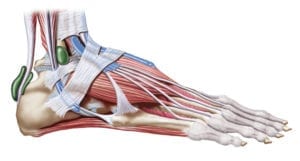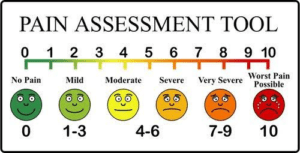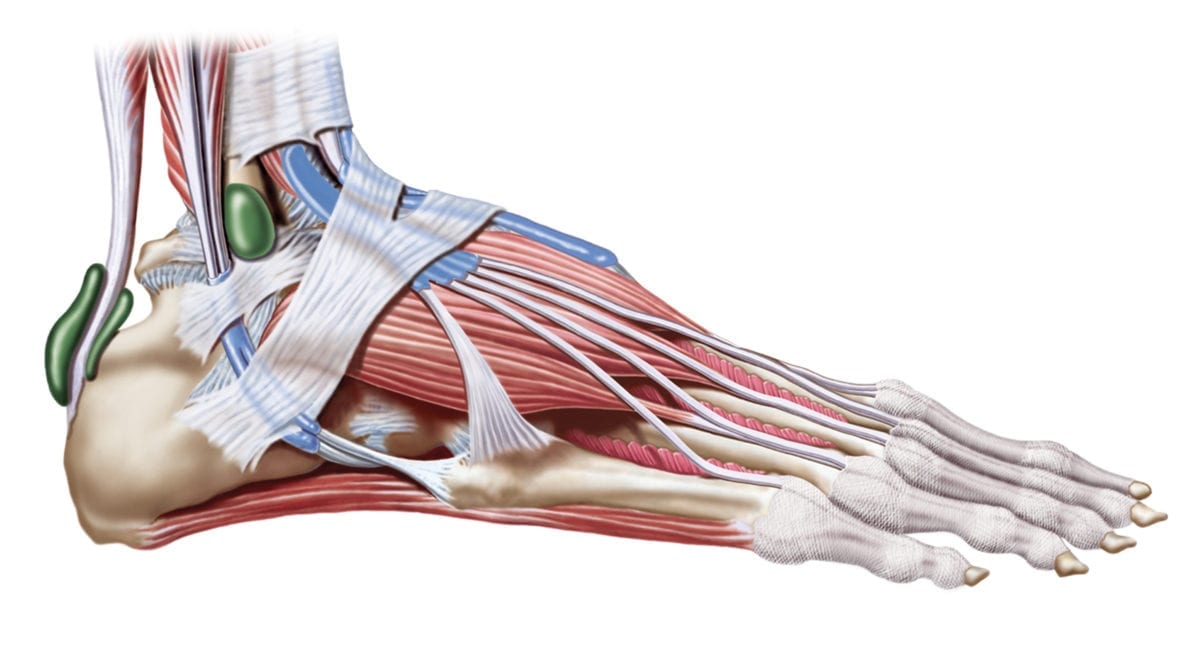Achillespees Bursitis
Zoals in het algemene blog over achillespees klachten te lezen is, zijn er verschillende soorten achillespees klachten. Dit artikel gaat alleen over de Bursitis achillespees klachten. Het is belangrijk om onderscheid te maken met andere types achillespeesklachten omdat de behandeling anders is!
Wat is Bursitis?
Bursitis is een irritatie/ontsteking van een slijmbeurs. In dit blog gaat het over de 2 verschillende slijmbeursen namelijk de Retrocalcaneal- en de superficial slijmbeurs.(zie afbeelding 1)

- De Retrocalcaneal slijmbeurs ligt tussen het hielbot en de achillespees.
- De superficial slijmbeurs ligt tussen de achillespees en de huid.
Symptomen
- Pijn rond de hiel net boven het hielbot.
- Roodheid, zwelling warmte rond de hiel.
- Drukpijn rond de hiel.
- Pijn bij beginnen van sport of meteen na het opstaan in de ochtend.
Test jezelf
Door de huid op het hielbot bij elkaar te knijpen met je duim en wijsvinger kan je testen of de superficial slijmbeurs de klachten geeft.
Door de net achter de achillespees te knijpen bij de aanhechting test je de Retrocalcaneal slijmbeurs.
Deze testen zijn niet perfect en het is altijd aan te raden om langs een specialist te gaan om dit te controleren.
Voorkom compressie
In het geval van slijmbeursklachten is het belangrijk om compressie te voorkomen. Om de compressie te verminderen is het belangrijk om de enkel niet verder dan 90graden te buigen (tenen naar je toe). Vermijd bijvoorbeeld heuvelop lopen of de heeldrop oefeningen.
Gebruik geen schoenen waarbij de hiel erg strak zit en hierdoor druk uitoefent op de aanhechting van je achillespees. Schoenen met een hogere hak kunnen mogelijk helpen om de druk te verminderen, je kan ook gebruikmaken van een hakverhoging.
En misschien wel het belangrijkste, ga de kuitspieren niet rekken! Rekken van de kuitspieren zorgt voor compressie en kan de klachten verergeren!
Wat kan je wel doen?
Stap 1 Isometrische oefeningen
Om de pijn te verminderen en de trekkrachten te controleren, is het belangrijk om de volgende twee oefeningen uit te voeren.
Oefening 1: Isometrisch vasthouden M. Soleus
Uitvoering: Ga op de tenen staan, buig de knieën tot ongeveer 90 graden en houd deze houding vol gedurende 15 seconden. Kom vervolgens langzaam weer met de hele voet op de grond.
Herhalingen: 3×10 herhalingen per kant.
Oefening 2: Isometrisch vasthouden M. Gasctrocnemius.
Uitvoering: Ga op de tenen staan, houd de knieën gestrekt en houd deze houding vol gedurende 15 seconden. Kom vervolgens langzaam weer met de hele voet op de grond.
Herhalingen: 3×10 herhalingen per kant.
Stap 2 Kracht verbeteren
Als de pijn weg is en de klachten er niet meer zijn kan je starten met het trainen van kracht van de kuitspieren. Hiervoor zijn calfraises de juiste oefeningen. Deze oefening moet je doen zowel met gestrekte en gebogen knie. Hieronder de uitleg van de oefening:
Oefening 1: Heelraise gestrekte knie
Uitvoering: Ga op 1 been staan. Kom nu gecontroleerd op de tenen staan. Zodra je het hoogste punt hebt bereikt kom je weer rustig terug tot je hele voet aan de grond staat.
Herhalingen: 3×10 herhalingen per kant.
Oefening 2: Heelraise gebogen knie
Uitvoering: Ga op 1 been staan met gebogen knie. Kom nu gecontroleerd op de tenen staan. Zodra je het hoogste punt hebt bereikt kom je weer rustig terug tot je hele voet aan de grond staat.
Herhalingen: 3×10 herhalingen per kant.
Tijdens deze oefening horen de klachten niet toe te nemen, als dit wel het geval is de oefening nog te zwaar voor dat moment. Wat belangrijk is bij oefening 2 heelraise gebogen knie is dat je hierbij geen toename van de klachten krijgt. Als dit wel zo is moet je de knie minder ver buigen. Start bijvoorbeeld met 10 tot 15 graden kniebuiging en bouw dit uit naar 25 graden.
Stap 3 Hardlopen!

Nu begin je weer met hardlopen! Het is belangrijk dat je rustig opstart, vraag hierbij om hulp van je therapeut. Zorg ervoor dat alles wat je doet nagenoeg pijnvrij is. Het kan zo zijn dat je toch wat gevoeligheid krijgt tijdens de opbouw, zolang die op een schaal van 0 tot 10 maximaal een 4 is hoef je je niet druk te maken. Als de klachten daarna maar weer wegtrekken. Zie afbeelding 2 als voorbeeld.
Naast het starten met lopen is het belangrijk om de volgende oefeningen te doen.
Oefening 1: Triple extention
Uitvoering: Ga op 1 been staan met gebogen knie, buig hierbij je romp iets voorover. Kom nu gecontroleerd op de tenen staan waarbij je gelijktijdig je knie en heup strekt. Zodra je het hoogste punt hebt bereikt kom je weer rustig terug tot je hele voet aan de grond staat.
Herhalingen: 3×10 herhalingen per kant.
Oefening 2: Calfraise gestrekte knie met weerstand
Uitvoering: Ga op 1 been staan. Doe een grote weerstandsband om je voeten en je schouders. Kom nu gecontroleerd op de tenen staan. Zodra je het hoogste punt hebt bereikt kom je weer rustig terug tot je hele voet aan de grond staat.
Herhalingen: 3×10 herhalingen per kant.
Oefening 3: Heelraise gebogen knie met weerstand
Uitvoering: Ga op 1 been staan met gebogen knie. Doe een grote weerstandsband om de voeten en de schouders. Kom nu gecontroleerd op de tenen staan. Zodra je het hoogste punt hebt bereikt kom je weer rustig terug tot je hele voet aan de grond staat.
Herhalingen: 3×10 herhalingen per kant.
Bij vragen neem gerust contact op!
